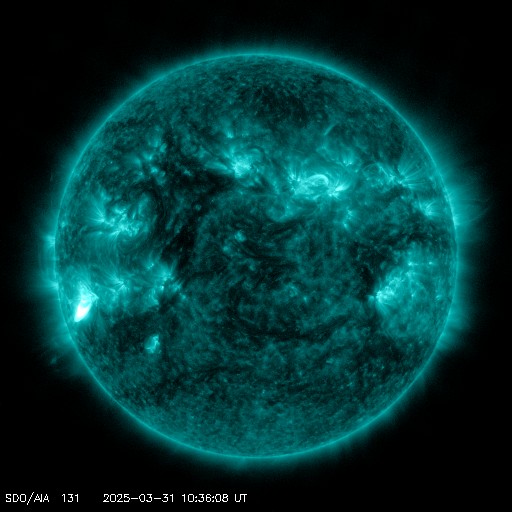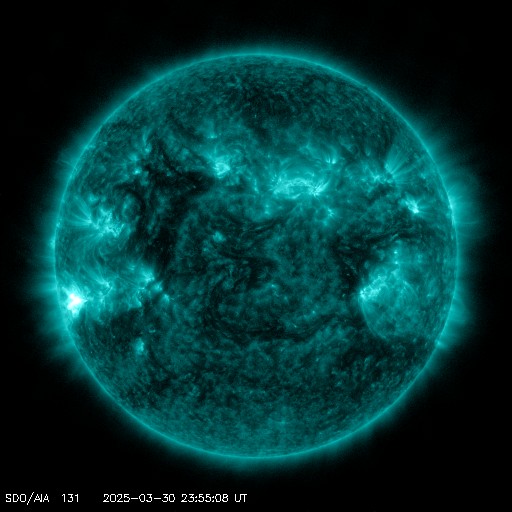Viewing archive of Tuesday, 29 July 2003
Solar activity report
Any mentioned solar flare in this report has a scaling factor applied by the Space Weather Prediction Center (SWPC). Because of the SWPC scaling factor, solar flares are reported as 42% smaller than for the science quality data. The scaling factor has been removed from our archived solar flare data to reflect the true physical units.
Report of Solar-Geophysical Activity 2003 Jul 29 2200 UTCPrepared by the NOAA © SWPC and processed by SpaceWeatherLive.com
Joint USAF/NOAA Report of Solar and Geophysical Activity
SDF Number 210 Issued at 2200Z on 29 Jul 2003IA. Analysis of Solar Active Regions and Activity from 28-2100Z to 29-2100Z
Solar activity increased to moderate levels. Region
421 (S08E54) produced an impulsive M1.3/1f flare at 29/0139Z. There
appears to be a weak gamma magnetic structure in the trailing
portion of the spot cluster and there was little apparent change to
the penumbral structure during the period. Region 422 (N14W54)
steadied in growth since yesterday and was limited to minor B and
C-class flares today. No new regions were numbered today.
IB. Solar Activity Forecast
Solar activity is expected to be at
low levels. Region 421 has the potential to produce an isolated
M-class flare
IIA. Geophysical Activity Summary 28-2100Z to 29-2100Z
The geomagnetic field was at predominantly active to minor storm
levels. A period of major storm conditions were observed at the
Boulder magnetometer between 29/0300 and 0600Z. The elevated
activity is in response to a recurrent coronal hole high speed solar
wind stream that has been ranging between 750 and 800 km/s
throughout the day. The greater than 2 MeV electron fluxes at
geosynchronous orbit reached high levels today.
IIB. Geophysical Activity Forecast
The geomagnetic field is
expected to be at predominantly active levels through the first two
days of the forecast period due to recurrent coronal hole high speed
stream effects. Occasional minor storm conditions are expected and
isolated major storm episodes may also be possible due to the
elevated solar wind speeds. Day three should see a decrease to
unsettled to active conditions with isolated minor storm intervals
possible at night side locations.
III. Event Probabilities 30 Jul to 01 Aug
| Class M | 35% | 35% | 35% |
| Class X | 10% | 10% | 10% |
| Proton | 01% | 01% | 01% |
| PCAF | green | ||
IV. Penticton 10.7 cm Flux
Observed 29 Jul 100 Predicted 30 Jul-01 Aug 100/105/105 90 Day Mean 29 Jul 125
V. Geomagnetic A Indices
Observed Afr/Ap 28 Jul 015/017 Estimated Afr/Ap 29 Jul 025/030 Predicted Afr/Ap 30 Jul-01 Aug 020/025-020/020-015/020
VI. Geomagnetic Activity Probabilities 30 Jul to 01 Aug
| A. Middle Latitudes | |||
|---|---|---|---|
| Active | 35% | 35% | 25% |
| Minor storm | 20% | 20% | 10% |
| Major-severe storm | 10% | 10% | 05% |
| B. High Latitudes | |||
|---|---|---|---|
| Active | 45% | 45% | 40% |
| Minor storm | 30% | 25% | 25% |
| Major-severe storm | 15% | 10% | 10% |
All times in UTC
Latest news
Latest forum messages
Unspecified geomagnetic activity 2151AR4048 42AR4046 137Solar Demon 3Aurora photography hints for those of us with smartphones 54
More topicsSupport SpaceWeatherLive.com!
A lot of people come to SpaceWeatherLive to follow the Sun's activity or if there is aurora to be seen, but with more traffic comes higher server costs. Consider a donation if you enjoy SpaceWeatherLive so we can keep the website online!

Latest alerts
11:15 UTC - Solar protons
Minor S1 Solar Radiation Storm - Minor impacts on HF radio through polar regions
10:45 UTC - Solar flare
Moderate M1.26 flare
10:27 UTC - Radio Blackout
Minor R1 radio blackout in progress (≥M1 - current: M1.22)
00:09 UTC - Solar flare
Moderate M1.03 flare
Sunday, 30 March 2025
23:51 UTC - Radio Blackout
Minor R1 radio blackout in progress (≥M1 - current: M1.03)
Space weather facts
| Last X-flare | 2025/03/28 | X1.1 |
| Last M-flare | 2025/03/31 | M1.2 |
| Last geomagnetic storm | 2025/03/27 | Kp5 (G1) |
| Spotless days | |
|---|---|
| Last spotless day | 2022/06/08 |
| Monthly mean Sunspot Number | |
|---|---|
| February 2025 | 154.6 +17.6 |
| March 2025 | 127 -27.6 |
| Last 30 days | 127 -25.7 |




